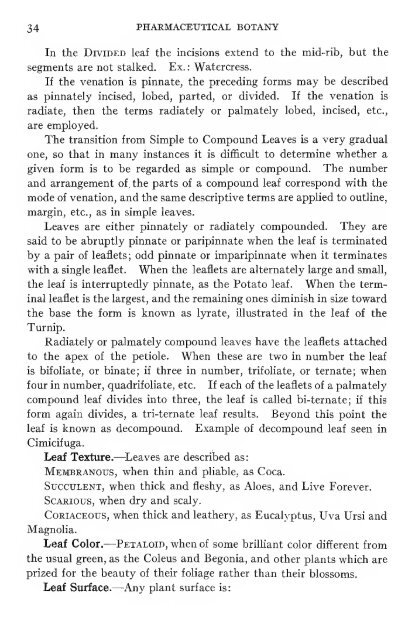Pharmaceutical botany - Lighthouse Survival Blog
Pharmaceutical botany - Lighthouse Survival Blog
Pharmaceutical botany - Lighthouse Survival Blog
You also want an ePaper? Increase the reach of your titles
YUMPU automatically turns print PDFs into web optimized ePapers that Google loves.
34<br />
PHARMACEUTICAL BOTANY<br />
In the Divided leaf the incisions extend to the mid-rib, but the<br />
segments are not stalked. Ex. : Watercress.<br />
If the venation is pinnate, the preceding forms may be described<br />
as pinnately incised, lobed, parted, or divided. If the venation is<br />
radiate, then the terms radiately or palmately lobed, incised, etc.,<br />
are employed.<br />
The transition from Simple to Compound Leaves is a very gradual<br />
one, so that in many instances it is difScult to determine whether a<br />
given form is to be regarded as simple or compound. The number<br />
and arrangement of. the parts of a compound leaf correspond with the<br />
mode of venation, and the same descriptive terms are applied to outline,<br />
margin, etc., as in simple leaves.<br />
Leaves are either pinnately or radiately compounded. They are<br />
said to be abruptly pinnate or paripinnate when the leaf is terminated<br />
by a pair of leaflets; odd pinnate or imparipinnate when it terminates<br />
with a single leaflet. When the leaflets are alternately large and small,<br />
the leaf is interruptedly pinnate, as the Potato leaf. When the term-<br />
inal leaflet is the largest, and the remaining ones diminish in size toward<br />
the base the form is known as lyrate, illustrated in the leaf of the<br />
Turnip.<br />
Radiately or palmately compound leaves have the leaflets attached<br />
to the apex of the petiole. When these are two in number the leaf<br />
is bifoliate, or binate; if three in number, trifoliate, or ternate; when<br />
four in number, quadrifoliate, etc. If each of the leaflets of a palmately<br />
compound leaf divides into three, the leaf is called bi-ternate; if this<br />
form again divides, a tri-ternate leaf results. Beyond this point the<br />
leaf is known as decompound. Example of decompound leaf seen in<br />
Cimicifuga.<br />
Leaf Texture.—Leaves are described as:<br />
Membranous, when thin and pliable, as Coca.<br />
Succulent, when thick and fleshy, as Aloes, and Live Forever.<br />
ScARious, when dry and scaly.<br />
Coriaceous, when thick and leathery, as Eucalyptus, Uva Ursi and<br />
Magnolia.<br />
Leaf Color.— Petaloid, when of some brilliant color different from<br />
the usual green, as the Coleus and Begonia, and other plants which are<br />
prized for the beauty of their foliage rather than their blossoms.<br />
Leaf Surface.—Any plant surface is:
















